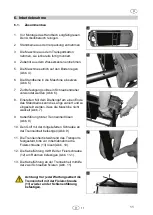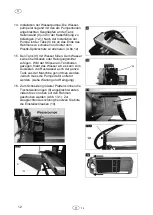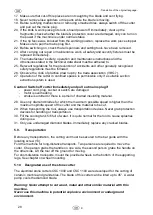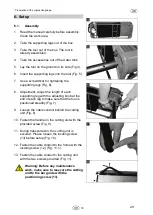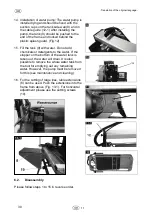
-Translation of the original language-
4
4. Technical specification
Type:
CSC 1000
CSC 1100
Voltage / frequency (V ~ Hz)
230 ~ 50
230 ~ 50
Power input: (W) /
Mode of operation S1:
900 W
900 W
Power input: (W) /
Mode of operation S2:
1,000 W – 30 min
1,000 W – 30 min
Insulation class
B
B
Protection class:
IP54
IP54
Idling speed (min
-1
):
2,950
2,950
Net weight
29.5 kg
34.5 kg
Blade dimensions (mm):
Ø 230 x Ø 22.23 x 2.0
Ø 230 x Ø 22.23 x 2.0
Max. cutting depth (mm):
50
50
Max. thickness of work piece (mm): 35
35
Max. cutting length (mm):
710
950
Table dimensions (mm):
1,010 x 400
1200 x 400
45° miter cut length (mm):
50 x 690
50 x 880
Tilting range:
0° to 45°
0° to 45°
Noise emission and vibrations
Values measured in accordance with EN 61029-1:2009 and EN 12418:
Sound pressure level:
•
Idle speed:
L
pA
67.3 dB(A), uncertainty K
pA
=3 dB
•
Operation:
L
pA
92.9 dB(A), uncertainty K
pA
=3 dB
Sound power level:
•
Idle speed:
L
WA
78.4 dB(A), uncertainty K
WA
=3 dB
•
Operation:
L
WA
101.8 dB(A), uncertainty K
WA
=3 dB
Total vibrations (vector sum of three directions) determined in accordance with
EN 61029-1:2009:
•
Vibration emission value a
h
= 2.31 m/s² - uncertainty K=1.5 m/s²
The vibration level determined in accordance with EN 61029-1:2009 is suitable for a
comparison of power tools. It can also be applied for a preliminary assessment of vibratory
stresses.
The vibration level represents the main applications of the power tool. If the tool is used for
different applications, with different insert bits or with inadequate maintenance, the
vibration level might differ. In this case, vibratory stresses during the whole working period
can increase significantly.
For an accurate assessment of vibratory stresses, those periods must also be taken into
account during which the tool is turned off or is running without being used. In this case,
vibratory stresses during the whole working period can decrease significantly.
Operators should be protected against vibrations by additional safety measures like:
regular maintenance of the tools, keeping their hands warm and appropriate organization
of operating sequences.
23



